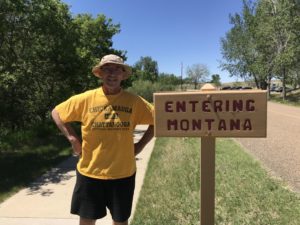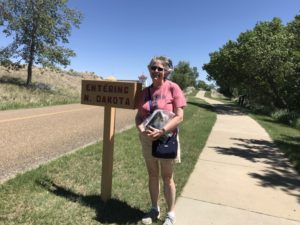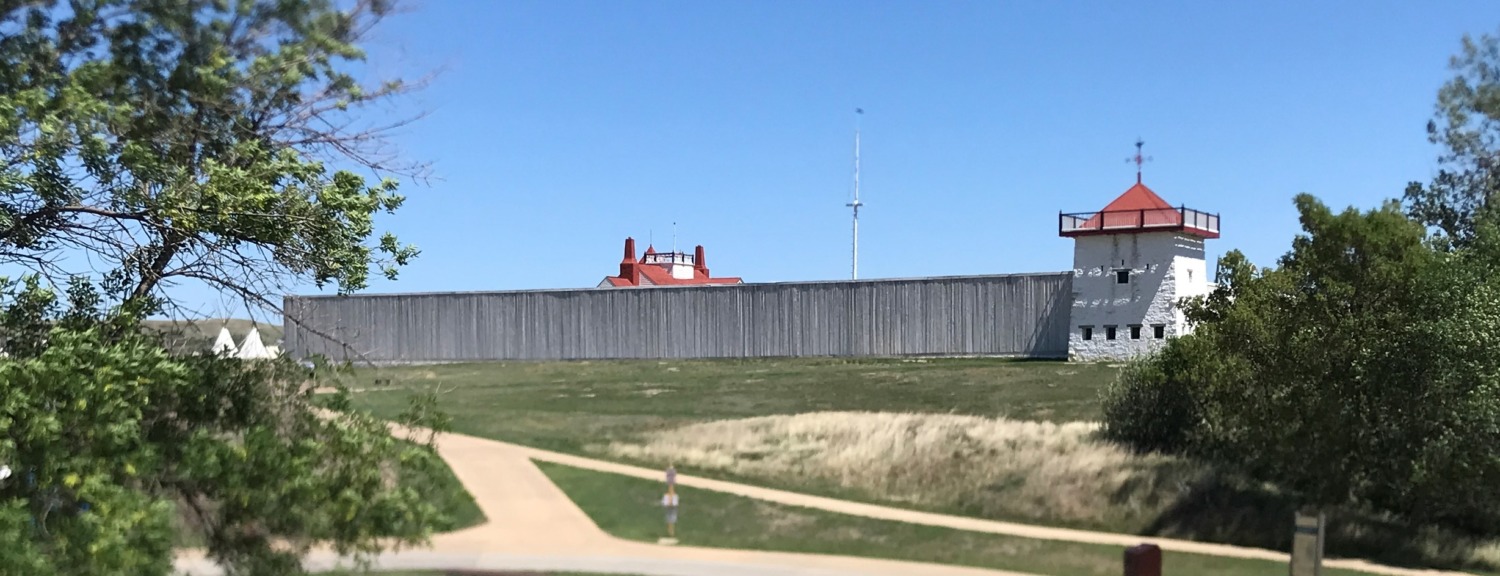Tom and I are working at Fort Union Trading Post National Historic Site for the summer. After having so little to write about in my blog for so long, I hardly know where to begin with all the new stuff around me. I want to write about everything, but I need to pace myself so I don’t run out of stuff to say before the end of September. Everything is new and exciting and interesting – for now!
I will start with a general overview of Fort Union Trading Post National Historic Site today and then expand on it each week. First, the location of Fort Union Trading Post. Fort Union is located on the Missouri River about a mile before the Yellowstone River confluence. It is as far west as you can go in North Dakota and still be in the state. In fact, the parking lot is in Montana and the Fort is in North Dakota.
The state line causes some funny moments because, not only it is in two states, it is in two different time zones. This part of North Dakota is on Central Time and Montana is on Mountain Time. Also, Montana doesn’t have a sales tax and people from Montana are surprised when we charge sales tax in our gift shop. We are 100 miles north of Theodore Roosevelt National Park and 60 miles south of Canada. The closest city is Williston, North Dakota, with a population of about 30,000.
Fort Union Trading Post was built by the American Fur Company, owned by John Jacob Astor, in 1828. By 1832, when the first paddleboat came up the Missouri River from St. Louis, the company was owned by Pierre Chouteau Jr. A delegation from the Assiniboine tribe had come to St. Louis and asked for the trading post to be built. They had already picked out the spot for it on good, flat land high above the river.
Native Americans from many different tribes – Mandan, Hidatsa, Arikara, Assiniboine, Sioux – came to trade furs at Fort Union in exchange for goods that they needed. Cloth was the #1 item traded because it wore out the fastest. Guns, metal pots, iron axes, tea, coffee, and sugar were also traded. At first beaver was the predominant fur. But, when the paddleboat came up the river, buffalo became the dominant fur. Before the paddleboats, buffalo hides were too heavy to be transported in a cost-effective way.

The Trading Post was run by a Bourgeoisie with clerks, traders, interpreters, and engagees (laborers) all living at the fort. Trade went on year-round, although summer time was the busiest time because it was easiest for everyone to travel to and from the fort. Over 200 trade goods from nine different countries were traded here for the furs. It was a partnership between the Native Americans and the Fur Traders with each getting something they valued in exchange. The men who lived and worked at the Fort were encouraged to marry into local tribes because that meant more connections and loyalty to the Fort.
For almost 40 years, Fort Union was a profitable place to do business. By the end of the Civil War, the world had changed. Encroaching settlement by Euro-Americans disrupted herds and hunting. Treaties narrowed the land allotted to the Native Americans. As more settlers came to “Indian Land,” the US government sent military who were supposed to protect the native rights, but spent most of their time enabling the settlers. In 1867 Pierre Chouteau and Company went out of business and sold Fort Union to the military. The Fort was torn down and the lumber used to build Fort Buford at the confluence of the Missouri and Yellowstone.
Tom and I are excited to be working in this beautiful place on the bluffs above the Missouri River. We have been learning the history of the place and are eager to share it with visitors to Fort Union Trading Post as well as with you.




